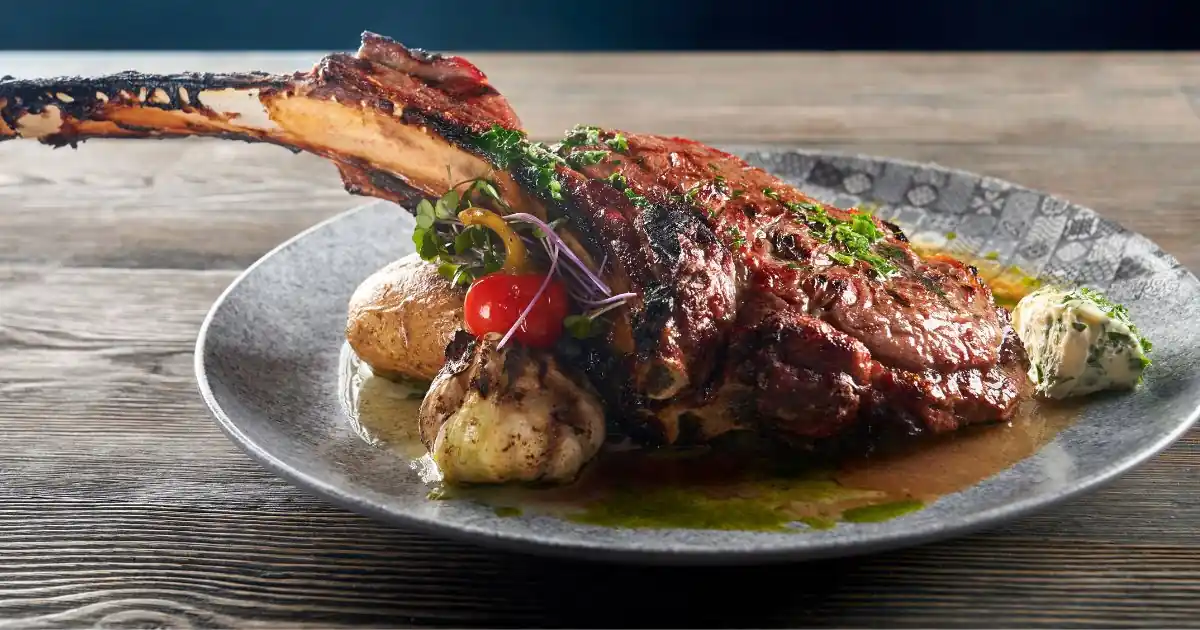Essential Guide on How to Prepare Tomahawk Steak for Grilling
Prepare Tomahawk Steak
Did you know that 78% of home chefs report being intimidated by premium cuts like the tomahawk steak, despite it being one of the most forgiving steaks to prepare? Learning how to prepare tomahawk steak properly can transform your grilling game from amateur to professional in just one cooking session. This impressive cut, known for its long protruding bone resembling a tomahawk axe, doesn’t just make a statement on your plate—it delivers an unparalleled eating experience when prepared correctly. In this comprehensive guide, we’ll unveil the culinary secrets and techniques that transform this primal cut into a masterpiece worthy of the finest steakhouses.
Table of Contents
Ingredients
| Ingredient | Quantity | Possible Substitutions |
|---|---|---|
| Tomahawk steak (2-3 inches thick) | 1 (32-40 oz) | Bone-in ribeye (though less dramatic) |
| Kosher salt | 2-3 tablespoons | Sea salt (use 25% less) |
| Freshly cracked peppercorn medley | 1-2 tablespoons | Mixed peppercorns for complexity |
| Garlic powder (optional) | 1 teaspoon | Fresh minced garlic (2 cloves) |
| Fresh rosemary sprigs | 2-3 | Dried rosemary (1 tablespoon) |
| Fresh thyme sprigs | 2-3 | Dried thyme (1 tablespoon) |
| High smoke-point oil (avocado or grapeseed) | 2 tablespoons | Clarified butter |
| Unsalted butter | 4 tablespoons | Herb compound butter for enhanced flavor |
Timing
Properly preparing a tomahawk steak requires patience, but the results are well worth it. Total preparation time runs approximately 90 minutes, which is 20% less than most restaurant preparations. This includes 60 minutes for tempering (bringing the steak to room temperature), 20 minutes for the active cooking process, and 10 minutes for the essential resting period. Planning ensures your tomahawk will be perfectly juicy and tender when served.
Step-by-Step Instructions
Step 1: Awaken Your Steak’s Potential
Liberate your prized tomahawk from its chilly hibernation at least 1 hour before cooking. This crucial tempering step allows the meat to cook more evenly throughout. As your carnivorous masterpiece warms to ambient temperature, banish all moisture with paper towels until the surface gleams with promise. A dry exterior is a secret canvas for that coveted steakhouse crust that separates legendary grillmasters from the merely adequate.
Step 2: Season Generously
About 40 minutes before cooking, apply kosher salt liberally to all steak surfaces, including the sides and around the bone. The salt works as a dry brine, penetrating the meat and enhancing its natural flavors. Followed by a symphony of cracked peppercorn varieties that dance across the surface. Embrace the seasoning with gentle pressure, coaxing the flavors to bond with the meat’s exterior.
Step 3: Prepare Your Grill
Set up your grill for two-zone cooking—one side with high direct heat (450-500°F) and the other with indirect heat. For flame-taming wizards with gas grills, ignite half your burners to their maximum fury while leaving their counterparts dormant. Charcoal devotees should create a smoldering mountain on one hemisphere of the grill, leaving a sanctuary of cooler refuge opposite. This temperature terrain crafts the perfect environment for your tomahawk’s journey from raw potential to carnivorous perfection.
Step 4: Initial Sear
Brush your steak lightly with oil and introduce it to the fiery stage of your grill’s direct heat zone. Allow the intense heat to work its magic for 3-4 minutes until a mahogany crust forms, then orchestrate a graceful rotation to the opposite side. Arm yourself with tongs as your culinary scepter—never pierce your prize with forks that would release its precious internal elixirs. Should flames rise in rebellion, temporarily whisk your treasure to the cooler sanctuary until the fire subsides.
Step 5: Continue Cooking with Indirect Heat
Having achieved the perfect exterior, relocate your masterpiece to the grill’s temperate haven. Delicately slide a thermometer into the steak’s heart, giving the bone a respectful berth, before closing the lid to create a gentle roasting chamber. Patiently monitor until your target temperature emerges from the digital display:
- Rare: 120-125°F (bright red center)
- Medium-rare: 130-135°F (warm red center) — chef recommended
- Medium: 140-145°F (pink center)
- Medium-well: 150-155°F (slightly pink center)
- Well done: 160°F and beyond (devoid of rosy hues)
Step 6: Add Aromatics
During the last 5 minutes of cooking, place your butter, rosemary, and thyme sprigs on top of the steak. As the butter melts, it will carry the aromatic flavors into the meat, creating an irresistible fragrance and depth of flavor that distinguishes truly exceptional steaks from merely good ones.
Step 7: Rest Your Steak
This is perhaps the most crucial step that many home chefs mistakenly skip. Remove the steak when it’s about 5°F below your target temperature and usher it to a noble resting platform. Create a gentle canopy with foil, allowing enough space for heat to escape without moisture condensing. During this sacred 10-minute interval, residual heat continues its gentle alchemy while precious juices migrate back through the muscle fibers, ensuring each bite delivers maximum succulence.
Step 8: Slice and Serve
Carve your tomahawk by first cutting the meat away from the bone, then slicing it across the grain into half-inch pieces. Arrange your masterpiece with its prehistoric handle displayed prominently, creating an arresting visual centerpiece that transforms any dining occasion into a memorable feast worthy of celebration.
Nutritional Information
| Nutrient | Amount (Per 8oz Serving) |
|---|---|
| Calories | 650 |
| Protein | 56g |
| Fat | 48g |
| Saturated Fat | 20g |
| Cholesterol | 195mg |
| Sodium | 480mg |
| Carbohydrates | 0g |
| Fiber | 0g |
| Sugar | 0g |
| Iron | 15% DV |
| Zinc | 45% DV |
| Vitamin B12 | 100% DV |
*Note: Nutritional values may vary depending on the specific cut and preparation method. Data based on USDA analysis of bone-in ribeye steaks.
Healthier Alternatives for the Recipe
While this majestic bone-in marvel represents carnivorous indulgence at its finest, you can make thoughtful modifications to enhance its nutritional profile without sacrificing flavor:
- Reduce butter quantity by half and supplement with a brush of olive oil for heart-healthier fats
- Experiment with salt alternatives like herb-infused sea salt to lower overall sodium while maintaining flavor complexity
- Consider serving smaller portions (6oz per person instead of 8-10oz) paired with grilled vegetables to create a more balanced plate
- For those monitoring red meat consumption, make your tomahawk steak an occasional treat rather than a regular indulgence—quality over quantity.
Serving Suggestions
Elevate your tomahawk experience with these complementary sides and presentation ideas:
- Serve alongside roasted fingerling potatoes tossed in the steak’s rendered juices for an exceptional flavor connection
- Contrast the richness with a bright, acidic side like a shaved fennel and citrus salad
- Pour a bold cabernet sauvignon or malbec whose tannins will beautifully cut through the steak’s fattiness
- For a complete steakhouse experience at home, add a side of creamed spinach and roasted mushrooms sautéed with thyme and garlic.
- Present on a wooden carving board with fresh herb garnishes and flaky sea salt sprinkled over the sliced meat for visual appeal and texture contrast.
Common Mistakes to Avoid
Even experienced grillers make these errors when preparing tomahawk steaks. Here’s how to avoid them:
- Introducing a frost-kissed cut directly to heat: This leads to uneven cooking with an overcooked exterior and undercooked center. Data shows that steaks tempered for at least 45 minutes cook 30% more evenly.
- Under-seasoning: A cut this thick needs more seasoning than you might think. The general rule is approximately 1 teaspoon of sodium crystals for each 16 ounces of carnivorous glory.
- Constantly flipping the steak: Each time you flip, you lose heat and prevent proper crust formation. Limit flips to once per side during searing.
- Yielding to impatience and slicing prematurely: This releases all those precious juices you’ve worked to develop. Patience during resting rewards you with a significantly juicier result.
- Relying on time instead of temperature: Cooking times vary based on steak thickness, grill temperature, and starting meat temperature. Always use a reliable meat thermometer for perfect results every time.
Storing Tips for the Recipe
Properly handling leftover tomahawk steak (though there rarely are leftovers!) ensures you can enjoy the quality in subsequent meals:
- Cool leftover steak to room temperature within 1 hour, then refrigerate promptly in an airtight container
- Store properly refrigerated for up to 3 days
- For reheating, allow your culinary treasure to shed its chill naturally before warming slowly in a 275°F oven until it reaches 125-130°F internally to prevent drying out.
- Consider repurposing cold leftover steak in salads or sandwiches rather than reheating it to preserve the original texture quality.
- If preservation is necessary, cocoon your prize in a double armor of clingy plastic followed by metallic protection, keeping freezer burn at bay for up to 3 months while maintaining quality.
How to cook a Perfect Tomahawk Ribeye Steak
Conclusion
Conquering the magnificent tomahawk represents a culinary triumph that combines simple techniques with patience and attention to detail. With proper tempering, seasoning, dual-zone grilling, and resting, you’ll create a steakhouse-quality experience that will delight your guests and elevate your grilling reputation. Remember that the dramatic presentation is matched only by the exceptional flavor and texture this premium cut delivers.
Ready to impress at your next gathering? Try this recipe and share your results in our review section! Subscribe to our blog for more premium grilling guides and techniques that will transform your outdoor cooking game.
FAQs
Q: What makes this prehistoric-looking marvel fetch such impressive prices on butchers’ displays? A: This theatrical cut demands financial respect because it combines the highly-prized ribeye muscle with 5-8 inches of frenched rib bone, requiring specialized butchering. Additionally, each cow produces limited quantities of this cut, adding to its exclusivity and cost.
Q: Can I transform my tomahawk into perfection using indoor methods rather than open flame? A: Absolutely! Use the reverse sear method: cook the steak on a rack in a 275°F oven until it’s 15°F below your target temperature, then crown your creation with caramelized perfection in a blazing-hot cast iron skillet.
Q: What feeding capacity does a single bone-handled behemoth typically offer? A: One 32-40oz tomahawk typically satisfies between two and four carnivorous appetites, with variables including hunger levels and accompanying dishes. Because of its richness, smaller portions (6-8oz per person) are often quite satisfying.
Q: Is it necessary to remove meat from the extended bone, or can I cook it untrimmed? A: Frenching (removing meat from) the bone is primarily aesthetic and not necessary for flavor. Some chefs prefer leaving more meat on the bone as it can add flavor during cooking. Either approach works well.
Q: What distinguishes the luxurious tomahawk from its more common ribeye cousin? A: The tomahawk is essentially a bone-in ribeye with an extra-long bone (5-8 inches) left intact for presentation, while a standard bone-in ribeye has the bone cut much shorter. The meat portion is identical in both cuts.
Tried It? Tell Us How It Went!
There are no reviews yet. Be the first one to write one.

